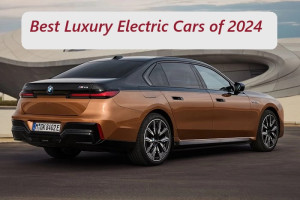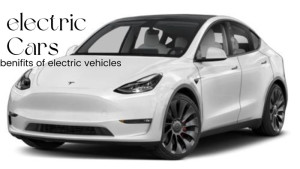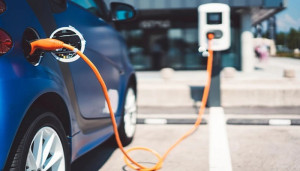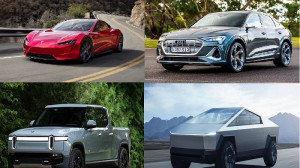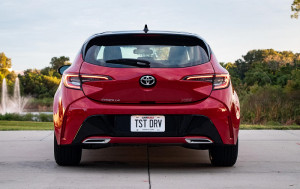The Future of Electric Cars: Trends and Predictions for 2024
Explore the dynamic landscape of electric cars in 2024

As we approach the dawn of a new age in transportation, the market for electric vehicles (EVs) is expanding at a rate never seen before. Twenty-two million electric cars were sold worldwide in 2012, a 55% rise over the previous year. EVs are starting to change the game. It's critical to comprehend the data and trends influencing the sector as we enter this fascinating new era of mobility. It is predicted that by 2024, over 17 million electric passenger cars will be sold worldwide, accounting for 25% of all new passenger car registrations.
Prediction of innovation expected regarding EV batteries in 2024:
Challenges regarding EV battery production? Nowadays, several challenges surround electric vehicle (EV) technology:
- There are limitations in battery technology, including concerns about the range and energy density, which still have room for improvement.
- Battery performance can be affected by colder weather, posing a challenge for EVs in such conditions. Ethical sourcing of battery materials, particularly cobalt, is another issue, with documented cases of unethical practices and environmental damage in the mining and production processes.
- There are recycling and disposal challenges, as used EV batteries require proper recycling to prevent environmental contamination.
In order to lower the cost of the EV battery, automakers and producers of EV batteries will concentrate on introducing new technologies and chemistries in 2024. The International Energy Agency (IEA) estimates that the battery can account for as much as 40% of an electric vehicle's cost. By reducing the amount of costly metals like lithium carbonate, nickel, and cobalt used in the cathode of EV batteries, new chemistries will be emphasized in 2024.
The two biggest EV companies in the world, Tesla and BYD, are among the automakers who have already switched to or invested in less costly battery technologies. Lithium iron phosphate (LFP) batteries are now being used by Tesla, and the company intends to increase its use in future semi-trucks. Additionally, BYD is working hard to produce sodium-ion batteries, which are a lot less expensive than conventional lithium batteries.
The transition to more affordable EV batteries in 2024 will be crucial in enabling EV companies to keep lowering costs and creating more alluring pricing plans for the general public. It will take some time for new material-based battery technologies to be produced and available on the market. Thus, patience will be required.

Also read: Electric Cars vs. Gas Cars: Which is Better for the Environment?
Shift to Tesla chargers:
Charging electric vehicles (EVs) is currently facing significant challenges, mainly revolving around issues of unreliability and inconsistency. Studies indicate that nearly one in five charging sessions encounters problems, with common issues including station connectivity difficulties, where chargers struggle to connect to the network, akin to experiencing dropped cell service for a gas pump. Internal faults, such as software glitches or hardware hiccups within the charger, can render it useless, introducing uncertainty into charging plans. Slow charging speeds further exacerbate the situation, with public chargers often delivering less power than advertised, especially in older units or those sharing a passion with other cars, leading to prolonged wait times. Additionally, compatibility problems arise due to different charging standards and adapters, making the process of plugging in only sometimes guaranteed and adding another potential source of frustration for EV users.
It is projected that Tesla will increase its market domination in the EV charging sector in 2024. Ford, General Motors, and Honda, among others, declared earlier in 2023 that they would be implementing Tesla's EV charging port—the North American Charging Standard (NACS) connector. Tesla has created an adapter that can be used to charge non-Tesla vehicles at its sites as a temporary fix. Over time, automakers will eventually directly integrate Tesla charger port compatibility into their cars; Ford, for instance, intends to start offering NACS ports on its new EVs in 2025.

Many have been shocked by the sluggish charging speed and unreliable nature of public chargers, which has led to the development of Tesla's extensive global network of superchargers, which now numbers over 50,000. This might be a game-changer for the business, which has had difficulty overcoming concerns about range anxiety. 42% of respondents to Euromonitor's Voice of the Customer: Mobility Survey 2023 stated that a lacklustre EV charging infrastructure prevented them from purchasing an EV.
By forming alliances with Tesla, more OEMs are likely to follow suit in 2024, which will position the NACS connection port to rule the EV charging industry. By the end of 2024, at least 7,500 Tesla chargers will be accessible for non-Tesla vehicles, according to the White House. This could help increase the acceptance of EVs among the general public, who frequently cite a shortage of charging stations as the primary obstacle to making the switch.
When the EV market moves into the mass market phase in 2024, it should be an exciting year. For OEMs to succeed in the upcoming year, they will need to invest in innovative solutions that directly address significant concerns and form strategic collaborations.
How the upfront cost of EVs is going to be reduced in 2024:
In 2024, a substantial reduction in upfront costs for electric vehicles (EVs) is anticipated, driven by a convergence of technological advancements, policy measures, and shifts in business models. Continued progress in battery innovations, such as increased energy density and faster charging times, is expected to lower the costs associated with EV batteries significantly. The development of solid-state batteries, though in early stages, holds promise for further cost reductions. Additionally, as EV production scales up, economies of scale and improved manufacturing processes are likely to contribute to a decrease in overall production costs. Standardization, with shared platforms and components across different EV models, is set to streamline production, further reducing manufacturing and assembly expenss.
Policy and incentives:
Policy and incentives are pivotal in this cost reduction forecast. Governments are expected to continue offering subsidies and tax breaks for EV purchases, potentially increasing these incentives in 2024. The growing market for used EVs provides a more affordable entry point for new buyers, complemented by innovative approaches like battery leasing or subscription models that separate the battery cost from the upfront vehicle price. Furthermore, business model shifts, such as the rise of subscription services where consumers pay a monthly fee for access to a fleet of EVs and increased adoption of ridesharing and carpooling, are set to reshape the landscape of individual car ownership. Together, these factors create a promising outlook for 2024, making EVs more financially accessible and appealing to a broader range of consumers.
What is laymen's responsibility regarding setting a trend towards EVs making air pollution-free:

Electric vehicles (EVs) promise a cleaner future by reducing air pollution, as they produce zero tailpipe emissions. With advancements in EV technology and increasing adoption, we anticipate a significant improvement in air quality and a healthier environment for all.
So as the global shift towards electric vehicles (EVs) gains momentum, everyday individuals, or "laymen," play a pivotal role in shaping the trajectory of EV development. One of the most impactful ways to contribute is by spreading awareness and education. Engaging in conversations with friends and family about the environmental and economic benefits of EVs helps demystify misconceptions. Joining online communities and supporting EV advocacy groups further amplifies this influence, creating a ripple effect of informed decision-making.
Laymen can also exert influence in the market by making conscious choices. Opting for an EV as their next vehicle not only aligns personal preferences with sustainability goals but also sends a powerful message to manufacturers about the growing demand for electric alternatives. Providing constructive feedback on EV experiences directly to manufacturers through surveys and online platforms enables continuous improvement in future models. Additionally, supporting local EV startups with investments or mentorship fosters innovation and diversification within the EV industry.
Promoting sustainable practices represents another avenue for laypeople to contribute significantly. Advocacy for clean energy policies, such as those favouring solar and wind power for EV charging, reinforces the environmental benefits of the entire EV ecosystem. Responsible charging habits, including the use of public charging stations and opting for green energy providers, further align personal choices with sustainability goals. By reducing overall carbon footprints through alternative transportation means like public transit, cycling, or walking, individuals contribute to a cleaner, healthier planet, emphasizing that even small actions collectively drive meaningful change in the evolution of EVs.

As we approach the dawn of a new age in transportation, the market for electric vehicles (EVs) is expanding at a rate never seen before. Twenty-two million electric cars were sold worldwide in 2012, a 55% rise over the previous year. EVs are starting to change the game. It's critical to comprehend the data and trends influencing the sector as we enter this fascinating new era of mobility. It is predicted that by 2024, over 17 million electric passenger cars will be sold worldwide, accounting for 25% of all new passenger car registrations.
Prediction of innovation expected regarding EV batteries in 2024:
Challenges regarding EV battery production? Nowadays, several challenges surround electric vehicle (EV) technology:
- There are limitations in battery technology, including concerns about the range and energy density, which still have room for improvement.
- Battery performance can be affected by colder weather, posing a challenge for EVs in such conditions. Ethical sourcing of battery materials, particularly cobalt, is another issue, with documented cases of unethical practices and environmental damage in the mining and production processes.
- There are recycling and disposal challenges, as used EV batteries require proper recycling to prevent environmental contamination.
In order to lower the cost of the EV battery, automakers and producers of EV batteries will concentrate on introducing new technologies and chemistries in 2024. The International Energy Agency (IEA) estimates that the battery can account for as much as 40% of an electric vehicle's cost. By reducing the amount of costly metals like lithium carbonate, nickel, and cobalt used in the cathode of EV batteries, new chemistries will be emphasized in 2024.
The two biggest EV companies in the world, Tesla and BYD, are among the automakers who have already switched to or invested in less costly battery technologies. Lithium iron phosphate (LFP) batteries are now being used by Tesla, and the company intends to increase its use in future semi-trucks. Additionally, BYD is working hard to produce sodium-ion batteries, which are a lot less expensive than conventional lithium batteries.
The transition to more affordable EV batteries in 2024 will be crucial in enabling EV companies to keep lowering costs and creating more alluring pricing plans for the general public. It will take some time for new material-based battery technologies to be produced and available on the market. Thus, patience will be required.

Also read: Electric Cars vs. Gas Cars: Which is Better for the Environment?
Shift to Tesla chargers:
Charging electric vehicles (EVs) is currently facing significant challenges, mainly revolving around issues of unreliability and inconsistency. Studies indicate that nearly one in five charging sessions encounters problems, with common issues including station connectivity difficulties, where chargers struggle to connect to the network, akin to experiencing dropped cell service for a gas pump. Internal faults, such as software glitches or hardware hiccups within the charger, can render it useless, introducing uncertainty into charging plans. Slow charging speeds further exacerbate the situation, with public chargers often delivering less power than advertised, especially in older units or those sharing a passion with other cars, leading to prolonged wait times. Additionally, compatibility problems arise due to different charging standards and adapters, making the process of plugging in only sometimes guaranteed and adding another potential source of frustration for EV users.
It is projected that Tesla will increase its market domination in the EV charging sector in 2024. Ford, General Motors, and Honda, among others, declared earlier in 2023 that they would be implementing Tesla's EV charging port—the North American Charging Standard (NACS) connector. Tesla has created an adapter that can be used to charge non-Tesla vehicles at its sites as a temporary fix. Over time, automakers will eventually directly integrate Tesla charger port compatibility into their cars; Ford, for instance, intends to start offering NACS ports on its new EVs in 2025.

Many have been shocked by the sluggish charging speed and unreliable nature of public chargers, which has led to the development of Tesla's extensive global network of superchargers, which now numbers over 50,000. This might be a game-changer for the business, which has had difficulty overcoming concerns about range anxiety. 42% of respondents to Euromonitor's Voice of the Customer: Mobility Survey 2023 stated that a lacklustre EV charging infrastructure prevented them from purchasing an EV.
By forming alliances with Tesla, more OEMs are likely to follow suit in 2024, which will position the NACS connection port to rule the EV charging industry. By the end of 2024, at least 7,500 Tesla chargers will be accessible for non-Tesla vehicles, according to the White House. This could help increase the acceptance of EVs among the general public, who frequently cite a shortage of charging stations as the primary obstacle to making the switch.
When the EV market moves into the mass market phase in 2024, it should be an exciting year. For OEMs to succeed in the upcoming year, they will need to invest in innovative solutions that directly address significant concerns and form strategic collaborations.
How the upfront cost of EVs is going to be reduced in 2024:
In 2024, a substantial reduction in upfront costs for electric vehicles (EVs) is anticipated, driven by a convergence of technological advancements, policy measures, and shifts in business models. Continued progress in battery innovations, such as increased energy density and faster charging times, is expected to lower the costs associated with EV batteries significantly. The development of solid-state batteries, though in early stages, holds promise for further cost reductions. Additionally, as EV production scales up, economies of scale and improved manufacturing processes are likely to contribute to a decrease in overall production costs. Standardization, with shared platforms and components across different EV models, is set to streamline production, further reducing manufacturing and assembly expenss.
Policy and incentives:
Policy and incentives are pivotal in this cost reduction forecast. Governments are expected to continue offering subsidies and tax breaks for EV purchases, potentially increasing these incentives in 2024. The growing market for used EVs provides a more affordable entry point for new buyers, complemented by innovative approaches like battery leasing or subscription models that separate the battery cost from the upfront vehicle price. Furthermore, business model shifts, such as the rise of subscription services where consumers pay a monthly fee for access to a fleet of EVs and increased adoption of ridesharing and carpooling, are set to reshape the landscape of individual car ownership. Together, these factors create a promising outlook for 2024, making EVs more financially accessible and appealing to a broader range of consumers.
What is laymen's responsibility regarding setting a trend towards EVs making air pollution-free:

Electric vehicles (EVs) promise a cleaner future by reducing air pollution, as they produce zero tailpipe emissions. With advancements in EV technology and increasing adoption, we anticipate a significant improvement in air quality and a healthier environment for all.
So as the global shift towards electric vehicles (EVs) gains momentum, everyday individuals, or "laymen," play a pivotal role in shaping the trajectory of EV development. One of the most impactful ways to contribute is by spreading awareness and education. Engaging in conversations with friends and family about the environmental and economic benefits of EVs helps demystify misconceptions. Joining online communities and supporting EV advocacy groups further amplifies this influence, creating a ripple effect of informed decision-making.
Laymen can also exert influence in the market by making conscious choices. Opting for an EV as their next vehicle not only aligns personal preferences with sustainability goals but also sends a powerful message to manufacturers about the growing demand for electric alternatives. Providing constructive feedback on EV experiences directly to manufacturers through surveys and online platforms enables continuous improvement in future models. Additionally, supporting local EV startups with investments or mentorship fosters innovation and diversification within the EV industry.
Promoting sustainable practices represents another avenue for laypeople to contribute significantly. Advocacy for clean energy policies, such as those favouring solar and wind power for EV charging, reinforces the environmental benefits of the entire EV ecosystem. Responsible charging habits, including the use of public charging stations and opting for green energy providers, further align personal choices with sustainability goals. By reducing overall carbon footprints through alternative transportation means like public transit, cycling, or walking, individuals contribute to a cleaner, healthier planet, emphasizing that even small actions collectively drive meaningful change in the evolution of EVs.

